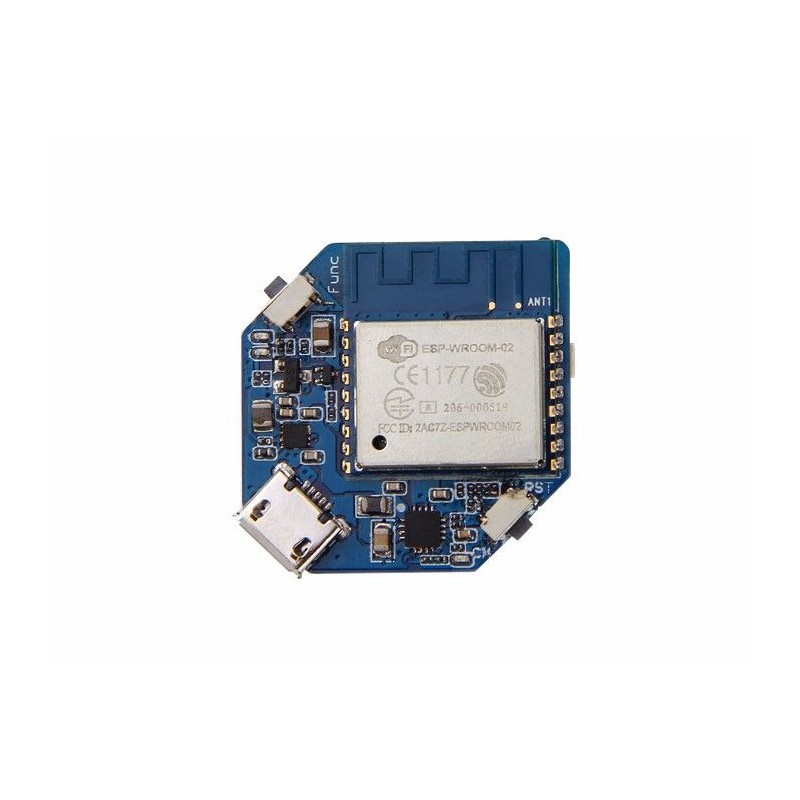- New





zł41.82 tax excl.
This ESP8266-based development board is designed for rapid IoT application development. It features support for two Grove Plug-n-Play connectors, digital and analog I/O, and UART and I2C interfaces for connecting multiple sensors and modules. The device supports OTA firmware updates, a RESTful API, and integration with mobile apps and IFTTT, allowing for easy remote control and monitoring. Seeed Studio 102110057
Wio Node is a compact and lightweight development board based on ESP8266, designed for rapid IoT application development. Despite its small size, Wio Node offers many features found in larger Wio models, such as support for Grove Plug-n-Play, OTA (Over-The-Air) firmware updates, RESTful API, as well as integration with IFTTT and mobile apps on Android and iOS. The board is intended for easy creation of IoT devices without the need for breadboards, soldering, or connection wires.

Wio Node supports 2 Grove connectors, providing 2 digital input/output pins, 1 analog input, 1 UART interface, and 2 I2C interfaces, allowing connection to up to 42 Grove modules and more in the future. Device configuration is visual and managed via the Wio APP mobile application, which allows sensor readings and actuator control. Due to its lightweight design and low cost, Wio Node is ideal for projects requiring multiple connected devices in IoT systems. Wio Node is an excellent solution for hobbyists, educators, and IoT prototype creators who need an affordable, compact, and easy-to-use platform for internet-connected smart devices.
Manufacturer BTC Korporacja sp. z o. o. Lwowska 5 05-120 Legionowo Poland sprzedaz@kamami.pl 22 767 36 20
Responsible person BTC Korporacja sp. z o. o. Lwowska 5 05-120 Legionowo Poland sprzedaz@kamami.pl 22 767 36 20
4-core cable, 20 cm long, terminated on both sides with a Grove plug. Compatible with the interface used in Seeed Studio and M5Stack modules. Seeed Studio 110990027
4-core cable, 50 cm long, terminated on both sides with a Grove plug. Compatible with the interface used in the M5Stack modules. M5Stack A034-C
A 4-core cable with a length of 50 cm, both terminated with a Grove plug. Seeed Studio 110990038
A 4-core cable with a length of 30 cm, both terminated with a Grove plug. Seeed Studio 110990040
4-core cable with a length of 15 cm, terminated on one end with a Grove plug, and on the other with a male goldpin connector. Seeed Studio 110990210
Adapter for ESP8266 modules dedicated to control addressable RGB LEDs from the WS2812 series
Wifi module with ESPR8266 ESPRESSIF for communication in the 2.4 GHz band. It is powered by a voltage from 3 V to 3.6 V, available in an SMD enclosure. ESP-WROOM-02
WiFi module with ESP8266 and 1.14" display, designed to work with Raspberry Pi Pico. It communicates via UART interface using AT commands. SB Components 21888
The module is based on the ESP8266EX chip. Thanks to the support of the 802.11 b/g/n standard, it enables wireless communication with WiFi networks, which allows for Internet access and data exchange. It is programmed via the USB Type-C connector using Arduino, MicroPython or NodeMCU. WeMos D1 Mini Type-C
Development board D1 Mini V3 with WiFi module ESP-8266 and 4 MB Flash memory. The module can be programmed from the Arduino IDE level. WeMos D1 Mini V3.x
Development board with ESP8266 microcontroller with built-in Wi-Fi communication. The system is clocked at 80 MHz and powered by 3.3 V. It includes a Tensillica core and a full Wi-Fi stack. Adafruit 3046
Plate for applications in the area of Internet of Things (IoT). The module was based on the ESP8266 system, which integrates WiFi, TCP / IP communication, 32-bit MCU, 10-bit ADC and many interfaces such as HSPI, UART, PWM, I2C and I2S. DFrobot DFR0489
WiFi module based on ESP8266. The module has a built-in antenna and USB-UART converter. The module can be programmed in Lua (under the control of the NodeMCU firmware) or in the Arduino environment. 10 GPIO lines are available which each can be configured to work as PWM, I2C.
Development kit with WiFi / Bluetooth module ESP8266 and 0.96 "OLED display.
WiFi 802.11 b/g/n module with ESP8266 system, 16 terminals are available with a 2 mm pitch with the possibility of soldering gold pins, there are 9 GPIO lines and 1 ADC line on the connector. Built-in ceramic antenna and U.FL antenna connector. ESP-07
Module with round 1.28" IPS LCD display and 240x240 px resolution and ESP-12E chip. SB Components 24025
Development board with RP2040 and ESP-12E microcontroller. Equipped with 0.91" OLED display. SB Components 24186
Development board D1 Mini with WiFi module ESP-8266MOD and 4 MB Flash memory. The module can be programmed from the Arduino IDE level. WeMos D1 Mini
WiFI 802.11 b/g/n module. Equipment includes, among others: LED diode, antenna, 8 pins with 2.54mm pitch (including 3 GPIO lines). Power supply: 3.3V.
WiFi module with ESP8266 designed to work with the Raspberry Pi Pico. It communicates via the UART interface using AT commands. Waveshare Pico-ESP8266
Easy to use app builder that allows users to add a variety of buttons, sliders, graphical displays and even RGB controllers to their phone. The SparkFun Blynk Board is specially designed to work with the ‘widgets’ within the Blynk mobile app to create your next IoT project. WRL-13794

This ESP8266-based development board is designed for rapid IoT application development. It features support for two Grove Plug-n-Play connectors, digital and analog I/O, and UART and I2C interfaces for connecting multiple sensors and modules. The device supports OTA firmware updates, a RESTful API, and integration with mobile apps and IFTTT, allowing for easy remote control and monitoring. Seeed Studio 102110057
